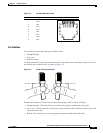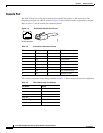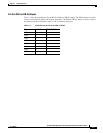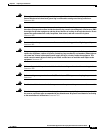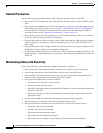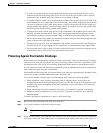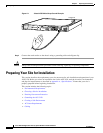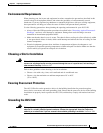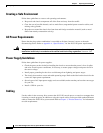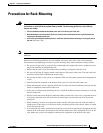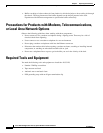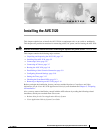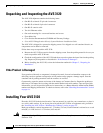
2-5
Cisco AVS 3120 Application Velocity System Hardware Installation Guide
OL-11805-01
Chapter 2 Preparing for Installation
Safety
• Use the correct external power source. Operate the product only from the type of power source
indicated on the electrical ratings label. If you are not sure of the type of power source required,
consult the Cisco Technical Assistance Center or a local power company.
• Use approved power cable(s) only. You have been provided with a power cable for your AVS 3120
that is intended for its use (approved for use in your country, based on the shipping location). Should
you have to purchase a power cable, ensure that it is rated for the product and for the voltage and
current marked on the product’s electrical ratings label. The voltage and current rating of the cable
should be greater than the ratings marked on the product.
• To help prevent electric shock, plug the AVS 3120, components, and peripheral power cables into
properly grounded electrical outlets. These cables are equipped with three-prong plugs to help
ensure proper grounding. Do not use adapter plugs or remove the grounding prong from a cable.
• Observe power strip ratings. Make sure that the total ampere rating of all products plugged into the
power strip does not exceed 80% of the rating.
• To help protect your AVS 3120 and components from sudden, transient increases and decreases in
electrical power, use a surge suppressor, line conditioner, or uninterruptible power supply (UPS).
• Do not modify power cables or plugs. Consult a licensed electrician or your power company for site
modifications. Always follow your local and national wiring rules.
Protecting Against Electrostatic Discharge
Static electricity can harm delicate components inside your product. To prevent static damage, discharge
static electricity from your body before you touch any of your product’s electronic components, such as
the microprocessor. You can do so by touching an unpainted metal surface on the equipment chassis.
As you continue to work inside the product, periodically touch an unpainted metal surface to remove any
static charge your body may have accumulated.
Work on ESD-sensitive parts only at an approved static-safe station on a grounded static dissipative work
surface, for example, an ESD workbench or static dissipative mat.
You can also take the following steps to prevent damage from electrostatic discharge (ESD):
• When unpacking a static-sensitive component from its shipping carton, do not remove the
component from the antistatic packing material until you are ready to install the component in your
computer. Just before unwrapping the antistatic packaging, be sure to discharge static electricity
from your body.
• When transporting a sensitive component, first place it in an antistatic container or packaging.
• Handle all sensitive components in a static-safe area. If possible, use antistatic floor pads and
workbench pads.
To remove and replace components in a chassis, follow these steps:
Step 1 Remove all static-generating items from your work area.
Step 2 Use a static dissipative work surface and wrist strap.
Note Disposable wrist straps, typically those included with an upgrade part, are designed for one time
use.
Step 3 Attach the wrist strap to your wrist and to the terminal on the work surface. If you are using a disposable
wrist strap, connect the wrist strap directly to an unpainted metal surface of the chassis. See Figure 2-1.



